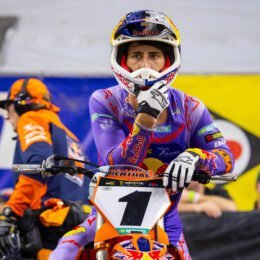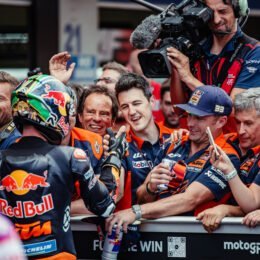MOLDING A MotoGP™ BIKE
Red Bull KTM Factory Racing’s Jack Miller is reaching the end of his first term with the KTM RC16 in MotoGP. The 28-year-old Australian has now ridden and taken podiums with three different bikes in the premier class. What exactly goes into shaping and creating a race ‘package’ that can top 360 kmph?
By Adam Wheeler

PC: Rob Gray
Jack Miller provided a shocking sight at the first round of 2023 MotoGP in Portugal. #43 was using his new RC16 to leap down the hill like it was a KTM SX-F, was performing ‘stoppies’ and bending the motorcycle to his will around the Algarve International Circuit like a KTM ‘veteran’. In fact, Miller had only accrued six full days on the bike before he had to enter the fierce heat of MotoGP competition, where aerodynamics and other prototype innovations are still squashing the best riders in the world together by slithers of a second. His level of comfort and familiarity and therefore speed opened the eyes of many watching, and he’s been a regular at the front of the MotoGP field ever since.

PC: Rob Gray | Polarity Photo
Jack is a talented rider, a multi Grand Prix winner with 23 podium appearances and a skilled motorcyclist regardless of the smoothness of the tires but this adaptation to the character and idiosyncrasies of a brand new bike was amazingly quick. Was it just about ergonomics? Was it also other customization factors? It’s no secret that Miller and his crew have been chasing the final tweaks of setup (electronics, balance, chassis) to convert from a top 7-8 campaigner to a more consistent podium challenger. “Yeah, that’s been the story for some GPs this year: I need more, and how do I get the feeling to be better?” he says to us, slightly wistfully. “The level is so high, and the level is always being pushed so you are always searching for that extra ‘bit’.”
‘Syncing’ with the RC16 was a fresh task this year and Miller quickly accomplished 80-90% in a matter of days and weeks. He has been working and searching for the rest and, of course, it can be a tricky and drawn-out process of trial and error. Today we’re interested in the 80-90%, which is already staggering when you consider the faith that Jack needs in his motorcycle to explore the limits of risk.

PC: Rob Gray | Polarity Photo
Jack, the first job with a brand-new race bike must be ergonomics, right? You need to find your position and ‘place’ with it…
Yeah, because you are hopping on something that someone else has ridden. You make it yours in terms of that first contact by feeling the bars, levers and pegs. But, to be honest, I don’t like to make many changes at first and like to roll out and understand how the bike is…because there are a number of reasons why it is set up like it is. Then you start to make changes as you see fit. A lot of people may have demands; like the seat being at a certain height or the levers at a certain angle but I think those settings are usually from another motorbike. I think you have to swallow your pride a bit and understand how the bike feels and works before you start to mold it.

PC: Rob Gray | Polarity Photo
Being that open-minded must be quite a discipline…
Sure, but you do that early in your career. I learned this approach during my years in MotoGP and the importance of looking in all areas for improvement. If you don’t then you can overlook a lot of things and miss stuff.
Is there much scope for personalization with the race bike?
Pretty much, and you get down to the nitty-gritty. On a motocross bike there is not all that much you can really change. Something like bar bend is, for us, the angle that we’ll have the clip-ons. I think we have the freedom to play around a lot more than those guys [motocrossers] do. They might play with footpeg heights and it’s the same for us but then we go further than where the pegs are and the lever positions; we have the location of the buttons, the dash and then it gets a bit more complex like where your knees sit in the fuel tank.

PC: Rob Gray | Polarity Photo
Do you get a feel for what you need after just a few laps?
Definitely. When I rolled out in Valencia [2022 and the one-day post season test] I felt like I was sat on top of the front tire! That’s not so much about ergonomics but the way the bike was setup to be very short and tight. I told the guys that I could not use the full power of the brakes like I’m used to or accelerate like I’d want to.
What about saddle and tank shape?
We’re still playing with that now and perhaps now more than ever. That’s the stuff you refine once you are comfy. You maybe want a little bit more grip here or support and contact area there. You never know until you actually go racing where you ‘are’…I think that’s the same in any sport when it comes to preparation. If you are putting on an act then it will soon disappear when it comes down to the racing; the same if you have been sand-bagging! It’s just about being as comfortable and as confident as you can. I find that I talk to myself: “this feels a little better” or “that doesn’t work” or “I can’t brake here” and you mentally make notes as you are riding. Your senses are on high-alert I guess, and you are picking up every little thing the bike is doing and being as precise as you can. You then need to remember it and be able to give that feedback to the boys in the box.

PC: Rob Gray | Polarity Photo
It must be cool to have something that advanced and specialized created specifically for you…
It’s a sick relationship to have. It can be a blessing and a curse because you can jump on someone’s else’s bike and think ‘this is a piece of s**t’ or ‘oh, this is alright’ but when you’ve built a bike yourself then you have to stick with it and it’s about taking responsibility. Obviously, we are only as good as the stuff we are given but that’s when your feedback and your comments are taken onboard – and it depends on how good the factory is – then you should be able to ride and race what you want.
The quality of the bike is also a reflection of your ability…
You try not to think about that too much…but obviously it is always there. If you have done your job properly then there should not be any questions to ask. You should feel right with your bike and if you are not then you shouldn’t be able to pass the blame to somebody else; you are the one telling them what to do.

PC: Rob Gray | Polarity Photo
By the same token, it must be very rewarding to develop something that can do the job…
Exactly. It is another one of those satisfying things. You might not be going great in the races at some points but you have to remember ‘big picture things’. When you look back and reflect then it is pretty cool to have had that opportunity to be in that position and be at one with a bike and work on it as much as we do. We have so many things we can change, tinker and touch. You can get lost pretty quickly but then that’s when you have to surround yourself with the right crew. At the end of the day you are paid to be a rider and not an engineer. All you can do is give your best feedback and hope to Christ that the boys can interpret it right. It is cool to look back and think ‘this thing is f**king fast…and we’ve done that’.










